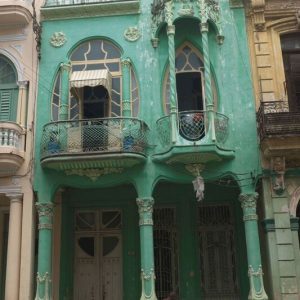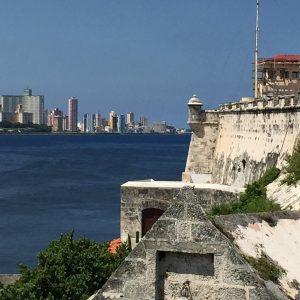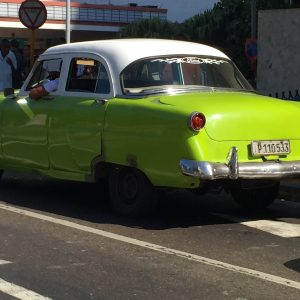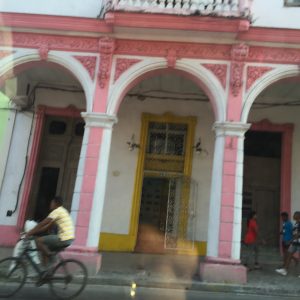Havana, Here WE Come!
Oct 11, 2016
One of the advantages of being an art critic is that you tend to receive an abundance of material to sift through each day, which arrives like clockwork electronically and magically overnight, appearing on my computer screen in the form of hundreds of press releases each morning.
It’s a great advantage to hear from so many galleries and museums on a regular basis, as it’s almost like visiting each show as a fly on the wall, buzzing from one loft to another. There also is a constant flow of publishers’ art-oriented books that come my way, often catching my attention and imagination, but unfortunately, I cannot find the time to read most of them, let alone pen a review. However, one book that drew my immediate attention recently was “Cutting Edge Art in Havana” by ARTempoCuba, a group of art historians, curators and other fine arts specialists who act as a leading resource for literally anyone interested in Cuban contemporary art and culture.
What also got my notice was that the book listed 100 professional artists, including profiles and images, that was an unexpected but delightful discovery for me. Perhaps the final mesmerizing push was that I have been following the amazing work of Cuban artist Kadir Lopez since discovering his work in a West Palm Beach collector’s home a few years ago, and I wondered out loud if I could find him listed in this book. And indeed, I spotted Kadir’s work on its pages; he is now universally considered the hottest Cuban artist in the world, and this prompted my interest in examining other artists in the book, and much to my delight the work represented was indeed first rate.
“Cutting Edge Art in Havana” eventually landed on my bedside table, which is a sure sign that I will get through it someday, perhaps on a rainy weekend afternoon. The more I looked, the more I learned about the remarkable variety and professionalism that these artists demonstrated in a country that is opening up slowly to rest of the world. I once highlighted Kadir in a magazine article about “Artists to Watch,” and was pleased to see him featured in The New York Times a few months later. My beat usually is in South Florida, and when it occurred to me that Cuba was only about an hour’s flight from Miami and finally opening up to visits without restrictions, my wife, Claudia and I, began making plans to finally see Havana. As this was unfamiliar territory, we received a reference to use the services of Havana VIP Tours, a travel agency that turned out to be a godsend as they specialize in arranging private tours of artists’ studios, interpreters, drivers, and historians and suggestions for what to do and where to go. We spent a long weekend there, and it turned out to be an enchanting experience.
The first thing we noticed was how small the airport was to serve a city of two and half million people, but it somehow works, even with the additional flights that are now landing each day. Once outside, bags in hand, we were met by a driver holding up a sign with my name on it as she leaned against her spectacular red and white ‘50s Chevy, which would be our distinguished wheels for the next few days. Under normal conditions it would seem like a big deal to see a car like this on the street in America, but I was stunned to see that many of the automobiles parked in the airport or waiting for passengers were eye-popping vintage vehicles, which seemed at first glance like rented cars for a movie set. If you did absolutely nothing but stand on a corner and watch the constant parade of roadworthy coupes pass by, with impossibly beautiful aged magnificent building façades as the backdrop, your trip would be worth it.
On your way into town, the only billboards are advertising revolutionaries, which serves as a reminder that you are indeed in a very different country with its own rules and regulations and way of living. We didn’t have a problem with anything other than realizing that we just couldn’t see everything on our agenda in only four days. But we were there primarily to visit independent artists in their Havana studios, which I had handpicked in advance from “Cutting Edge Art in Havana.” It’s not possible to mention here all the artists with whom we spoke, but suffice it to say from a man who has spent the last thirty years visiting hundreds of artist studios annually, that this tour was by far the most interesting of my life. I spent a month visiting artists in the then-USSR thirty years ago while it was still a communist country, but nothing could compare favorably with the distinct quality and tropical flavor of Cuba that is really quite astonishing.
Quoting from the book: “Today’s Cuban artist is an interesting subject. With the collapse of the paradigm of ‘State Authorization,’ Cuban artists have been immersed in a constant movement between the local and the global, not only in terms of ideo-aesthetic approaches in many of their creations, but also in terms of how they can afford to comply with the established rules of a global art market abroad, and then break them in their own backyard as they adopt the rules of the idiosyncratic network of relationships that govern Cuban artistic life.”
There is much more to say and to see about why it’s worthwhile to visit Cuba, and I plan to write about it again soon. Until then, I recommend getting a copy of “Cutting Edge in Art in Havana” (Amazon) which lists the top 100 Cuban artists, maps of art districts, choice restaurants and a variety of other points of interest. If this is your first trip, we advocate contacting ARTempoCuba and Havana VIP Tours.
Author

Bruce Helander
Bruce Helander is a former White House Fellow of the National Endowment for the Arts and is the former Editor-in-Chief of The Art Economist magazine. His columns on art, values, and investing in art appear regularly in The Huffington Post.

:sharpen(level=0):output(format=jpeg)/wp-content/uploads/2016/10/havana-here-we-come.jpg)




:sharpen(level=1):output(format=jpeg)/wp-content/uploads/2024/05/The-Art-Lawyers-Diary-1.jpg)
:sharpen(level=1):output(format=jpeg)/wp-content/uploads/2024/04/5-Questions-with-Bianca-Cutait-part-2-1.jpg)
:sharpen(level=1):output(format=jpeg)/wp-content/uploads/2024/05/20231208_164023-scaled-e1714747141683.jpg)
:sharpen(level=1):output(format=jpeg)/wp-content/uploads/2024/04/header.jpg)
:sharpen(level=1):output(format=jpeg)/wp-content/uploads/2024/04/5-Questions-with-Bianca-Cutait-part-1-1.jpg)
:sharpen(level=1):output(format=jpeg)/wp-content/uploads/2024/03/5-Questions-with-Alaina-Simone-1.jpg)